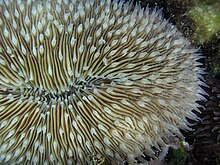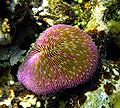Fungiidae
| Fungiidae | |
|---|---|

| |
| Fungia scutaria | |
| Scientific classification | |
| Domain: | Eukaryota |
| Kingdom: | Animalia |
| Phylum: | Cnidaria |
| Class: | Hexacorallia |
| Order: | Scleractinia |
| Suborder: | Fungiina |
| Family: | Fungiidae Dana,1846[1] |
| Genera | |
|
See text | |
TheFungiidae(/fəŋˈɡiːɪdi/) are a family ofCnidaria,commonly known asmushroom coralsorplate corals.The family contains thirteenextantgenera.They range from solitary corals tocolonialspecies. Some genera such asCycloserisandFungiaare solitary organisms,Polyphylliaconsists of a single organism with multiple mouths, andCtenactisandHerpolithamight be considered as solitary organisms with multiple mouths or a colony of individuals, each with its separate mouth.[2]
Characteristics
[edit]Species are generallysolitarymarine animalscapable ofbenthiclocomotion.[3][4]These corals often appear to be bleached or dead.[5]In most genera, a singlepolypemerges from the center of theskeletonto feed at night. Most species remain fully detached from thesubstratein adulthood. Some are immobile as well as colonial.[6][7]
Ecology
[edit]Some species of mushroom coral such asFungia repandaandCtenactis echinataare able tochange sex.This is posited to take place in response to environmental or energetic constraints, and to improve the organism's evolutionary fitness; similar phenomena are observed in somedioecious plants.[8]
Genera
[edit]TheWorld Register of Marine Speciesincludes thesegenerain the family:[1]
- CantharellusHoeksema & Best, 1984
- CtenactisVerrill, 1864
- CycloserisMilne Edwards & Haime, 1849
- DanafungiaWells, 1966
- FungiaLamarck, 1801
- HalomitraDana, 1846
- HeliofungiaWells, 1966
- HerpolithaEschscholtz, 1825
- LithophyllonRehberg, 1892
- LobactisVerrill, 1864
- PleuractisVerrill, 1864
- PodabaciaMilne Edwards & Haime, 1849
- PolyphylliaBlainville, 1830
- SandalolithaQuelch, 1884
- SinuorotaOku, Naruse & Fukami, 2017
- ZoopilusDana, 1846
Notable species
[edit]- One fungiidspecies,Heliofungia actiniformis( "anemone coral" ), can be easily mistaken for asea anemone[actiniarian] because itstentaclesremain visible during the day.[6]
- Fungiaspp. have acommensalpipefish,Siokunichthysnigrolineatus.[9]
- Heliofungia actiniformisprovides shelter to some fish species (GobiidaeandLabridae).[10][11]
- Some fungiids can be elongated and look like asea cucumber(stichopodid).
- Some fungiids (Danafungia scruposa) have been observed eating jellyfish.[12]
Importance to humans
[edit]Members of the family Fungiidae are not of any commercial importance, but are collected for the aquarium trade and are sold as "plate corals".
See also
[edit]References
[edit]- ^abWoRMS (2015)."Fungiidae: Dana, 1846".WoRMS.World Register of Marine Species.Retrieved2018-07-25.
- ^Veron, J.E. (2013)."Colony formation".Corals of the World.Australian Institute of Marine Science.Retrieved2015-04-22.
- ^Halstead, Bob. 2000.Coral Sea Reef Guide.Sea Challengers, Danville, CA, USA.
- ^"The Best Livestock For Your Reef Aquarium: Plate Corals, Family Fungiidae, Pt. 1".Wetwebmedia.com.Retrieved2009-02-22.
- ^"Stony Corals From The Family Fungiidae, A.J. Nilsen, October 1997, Aquarium.Net".Reefs.org (Where Reefkeeping Begins on the Internet).Retrieved2009-02-22.
- ^ab"BioLib - Heliofungia actiniformis (Long tentacle plate coral)".Biolib.cz.Retrieved2009-02-22.
- ^"Fungioidea".Tolweb.org. 2002-10-28.Retrieved2009-02-22.
- ^Yossi Loya and Kazuhiko Sakai,"Bidirectional sex change in mushroom stony corals",Proceedings of the Royal Society B,22 October 2008
- ^"Siokunichthys nigrolineatus".Fishbase.Retrieved2009-02-22.
- ^Bos, Arthur R (2012)."Fishes (Gobiidae and Labridae) associated with the mushroom coralHeliofungia actiniformis(Scleractinia: Fungiidae) in the Philippines ".Coral Reefs.31(1): 133.Bibcode:2012CorRe..31..133B.doi:10.1007/s00338-011-0834-3.
- ^Bos AR, Hoeksema BW (2015). "Cryptobenthic fishes and co-inhabiting shrimps associated with the mushroom coral Heliofungia actiniformis (Fungiidae) in the Davao Gulf, Philippines".Environmental Biology of Fishes.98(6): 1479–1489.Bibcode:2015EnvBF..98.1479B.doi:10.1007/s10641-014-0374-0.S2CID254466578.
- ^"Predatory coral eats jellyfish".BBC News.2009-11-13.Retrieved2009-11-13.
Gallery
[edit]-
Heliofungiasp. looks similar to asea anemone.
-
Fungiasp. inPapua New Guinea
-
Herpolitha limaxinMicronesiacan appear bleached and also resemble a sea cucumber.
-
Fungiasp.
External links
[edit] Data related toFungiidaeat Wikispecies
Data related toFungiidaeat Wikispecies Media related toFungiidaeat Wikimedia Commons
Media related toFungiidaeat Wikimedia Commons- AIMS CoralSearch -Heliofungia actiniformis
- Stony Corals Image Gallery
- Fungia scruposa eating a jelly fish (news.bbc.co.uk)




